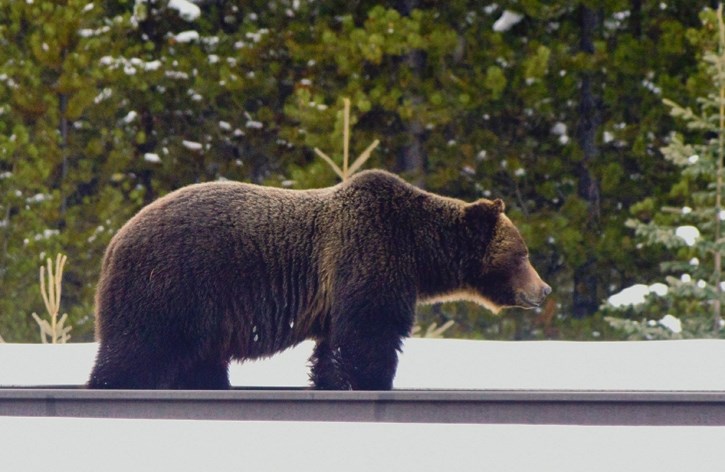The grizzly bear population in Banff, Yoho and Kootenay national parks is stable, according to researchers who have developed a new, cost-effective way of monitoring wildlife populations.
A study published in June highlights a new way to estimate population abundance, using existing data from radio collars and cameras already being used for other studies, along with a new generalized spatial mark-resight model.
Using this information, researchers found Banff’s grizzly population has remained relatively unchanged since a 2006-08 DNA study. Population density is estimated to be approximately 13 bears per 1,000 square kilometres.
“We found that the population of grizzly bears is stable, which is important for conservation of grizzly bears throughout the Rockies,” said Jesse Whittington, a Banff National Park wildlife ecologist who led the study.
The peer-reviewed study was published in Journal of Applied Ecology last month. Whittington worked with Richard Chandler, one of the world’s leading population ecologists, and Mark Hebblewhite, a renowned wildlife conservation scientist.
Grizzly bear populations and trends have traditionally been monitored using DNA-based studies, whereby DNA collected from hair or scat samples identifies individual bears.
Grizzly bears are a threatened species in Alberta.
Whittington said when Parks Canada considered doing a DNA study in 2012, to follow up on previous research from a 2006-08 study, the cost at that time was pegged at roughly $500,000.
Given the explosion in remote camera numbers and the high number of radio-collaring studies, he said population density in many cases could be estimated with minimal additional costs.
Whittington said wildlife managers around the world strive to estimate population abundance and density.
“What’s really exciting for me is there’s been an explosion in the use of remote cameras to monitor wildlife throughout the world and a lot of ongoing radio-collaring projects,” he said.
“It’s very likely that many research projects can take advantage of existing GPS and camera data to monitor populations with minimal extra costs.”
Researchers used information from grizzly bears captured as part of the Parks Canada-Canadian Pacific Railway joint plan, as well as images from cameras located throughout the front country and backcountry.
The cameras recorded 614 detections of 22 radio-collared grizzly bears and 1,354 detections of unmarked bears.
“Remote cameras detected radio-collared and un-collared grizzly bears over 2,000 times over three years,” said Whittington.
“With our high rates of detection, we were able to do density estimates with really high confidence intervals.”
The density estimate of 13 grizzles per 1,000 square kilometres, rather than absolute number of animals, is said to be the preferred way for many scientists to monitor populations.
That’s because models assume grizzly bear density is equal across the 4,000 square kilometre study area, yet habitat quality varies greatly from productive valley bottoms to rockier areas along the Continental Divide.
Whittington said the next step is to find a way to accurately link grizzly bear density to habitat quality.
“If people want, they can extrapolate numbers themselves, but I’m not confident in doing so because I think to do it properly you do need to link density to habitat quality,” he said.
“In the scientific world, studies compare density rather than number of animals.”
Jody Hilty, president and scientist with Yellowstone to Yukon (Y2Y) Conservation Initiative, welcomed the research from this new study.
“In terms of the outcome of the population being at a stable density, I think that’s what we would expect in a protected system,” she said, noting Parks Canada continues to manage its bear population well.
“It’s reassuring even though we’re seeing changes with increased visitation and climate change and all those things that vary from year to year, that they seem to be doing quite well.”
Hilty, who used cameras 20 years ago as part of research looking at large carnivores in California, said it’s exciting to see how camera technology continues to be developed over time.
“It’s great we can monitor wildlife populations using non-invasive techniques,” she said. “It’s important in terms of making sure that animals at such low density don’t blink out without us noticing.”
Researchers moved away from the traditional spatial mark-resight models, which use detection rates of radio-collared and unmarked animals at remote cameras to estimate density.
However, these models assume that radio-collared animals are found randomly throughout the landscape, whereas in the case of this particular study, bears were only trapped and collared in the Bow Valley and Kicking Horse Valley.
“Had we used the traditional model, we would have found a 51 per cent decline in Banff’s grizzly bear population,” said Whittington.
“Our generalized spatial mark-resight model addresses this problem by including detection rates at both trap sites and remote cameras to produce robust density estimates.”
Whittington said Parks Canada works hard to protect national park grizzly bear populations, noting the fact that this research shows the population is stable is encouraging.
He said grizzly bears regularly use highway underpasses and overpasses to get from one side to the other, feed in rejuvenated prescribed burn areas and make use of secure habitat. For example, there’s an annual seasonal closure in the Spray River Valley where there’s a high concentration of bears.
“We had bears like 64 and 72 that leaned how to navigate, survive and reproduce in a busy landscape,” said Whittington, noting those two well-known bears died naturally of old age.
“They’re no longer with us, but we now have to help their offspring, such as 148, to live to old age and successfully reproduce herself.”




